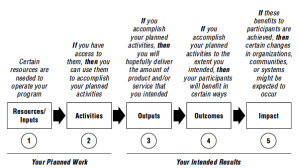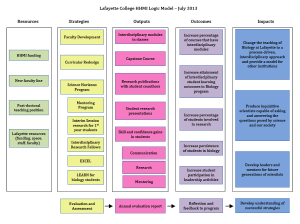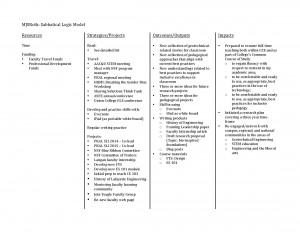Logic Models
As an academic, in a faculty or administrative role, I frequently have needed to work with others to create a grant proposal or to develop and move forward a new strategic initiative. An approach that I have found useful in both situations is to develop and use a logic model.
Logic models were first described over thirty years ago by Wholey (1983) and McLaughlin and Jordan (199) summarize their early evolution and use. The logic model approach has also been called “chains of reasoning”, “theory of action”, “performance framework”, and “logical framework” (McLaughlin and Jordan, 1999).
The W. K. Kellogg Foundation (1998, 2004) has promoted the logic model approach as an approach to program evaluation and gives the following definition:
The program logic model is defined as a picture of how your organization does its work – the theory and assumptions underlying the program. A program logic model links outcomes (both short- and long-term) with program activities/processes and the theoretical assumptions/principles of the program. (p. III, 2004)
The Kellogg Foundation also noted that “[the logic model approach] facilitate[s] thinking, planning, and communications about program objectives and actual accomplishments… Developing and using logic models is an important step in building community capacity and strengthening community voice.” (p. III, 2004)
Originally promoted by private foundations such as the Kellogg Foundation and the Howard Hughes Medical Institute, logic models are now also found in proposals and project reports written for the National Science Foundation and other government agencies.
A logic model is probably best described using a picture such as used in the 2004 Kellogg report and shown in Figure 1.
Figure 1. The basic logic model (Kellogg, p. 1)
The basic elements of a logic model include the following:
Impacts—Normally shown at the right side of the model, the impacts are the long-term effects of the program. These impacts typically are achieved sometime beyond the lifetime of the program. (The process of developing a logic model is described below but describing the impact is the first step in creating the model.)
Outcomes—Specific changes in program participants’ behavior, knowledge, and/or skills that result because of the program are the outcomes. These outcomes can be short-term or long-term.
Outputs—The direct products of planned activities (or strategies) are the outputs for the program. These might be physical results such as documents or they may be the data that is collected, e.g., the numbers of participants, their demographics, and/or responses to surveys.
Activities—The strategies/actions that are planned so that the desired outputs and outcomes will be achieved are the planned activities
Resources/Inputs—The funds, personnel, and equipment are the resources/inputs required to put in place the activities that are planned.
A logic model is typically created by a group of people who have the experience and knowledge required to develop a project or program that aligns with a desired set of outcomes or impact. (In the case of a small project such as a new course proposal, an individual can also develop the logic model.) Once the team is formed, the process described below is recommended and is based on the elements described above and illustrated in Figure 1:
…start at the RIGHT by defining the program’s envisioned impacts. Consider your intended impacts—the outcomes that will lead to this vision should become apparent. As you continue to work toward the left, the measurable outputs and the strategies you will use to achieve these outcomes/impacts should become apparent. From there, the resources, or inputs, necessary to carry out your project will emerge. (HHMI, undated, p. 3)
Developing a logic model typically takes time and may require scheduling a retreat or a series of meetings.
Once developed, the model can be read as a series of “if…then…” statements as illustrated in Figure 2.
Figure 2. How to read a logic model (Kellogg, 2004, p. 3)
To illustrate the use of this approach, I describe examples of two logic models below: the logic model developed during the preparation of the proposal that led to Lafayette College’s current grant from the Howard Hughes Medical Institute and the logic model that I developed as I considered the impacts and outcomes I wanted to achieve during my current sabbatical.
Lafayette’s HHMI grant
In developing the proposal for Lafayette’s current HHMI funded grant, I worked with the faculty in the biology department to develop the logic model shown in Figure 3.
Figure 3. Logic model for Lafayette College’s current HHMI grant. (For a better graphic, see 2013-07-06 – HHMI lafayette logic model )
The columns in this model provide brief descriptions of the impacts, outcomes, outputs, strategies, and resources associated with the funded project. This model is now referenced regularly by the faculty who are directing the project and is modified as needed (i.e., it is considered a working document). Specifically, the model is used hand-in-hand with the assessment activities described briefly in the boxes shown along the bottom of the model. If assessment data related to the desired outcomes and outputs—data gathered continuously during grant activities—demonstrates that specific strategies are not effective, those strategies can be modified in response to that data.
Sabbatical Plan
As I began my sabbatical after eight years in various administrative roles, I found it useful to develop a logic model to help me stay focused on the goals (impacts) I hope to achieve during my sabbatical. Figure 4 shows the current version of that logic model. (Note, I find it more useful to combine outcomes and outputs into a single column in this situation.) Like the logic model for the HHMI grant above, the logic model for my sabbatical is a working document and, while the desired impacts are unlikely to change, I do anticipate that the listed outcomes/outputs and strategies/projects may evolve over time.
Figure 4. Sabbatical logic model. (For a better graphic see, Sabbatical Logic Model)
A logic model is a useful framework for developing a new initiative. By first focusing on the desired impacts and then working back through outcomes/outputs, effective strategies, and needed resources, it is possible to create a working document that can be used to develop an effective proposal as well as a document that can be referred to on a regular basis to assess the success of the project and its alignment with the desired impacts.
Resources
Howard Hughes Medical Institute. (Undated). Mapping Your Science Education Program. Retrieved from http://www.hhmi.org/sites/default/files/Programs/hhmi_map_and_measure.pdf.
McLaughlin, J.A., and Jordan, G.B. (1999). Logic Models: A Tool for Telling Your Program’s Performance Story. Evaluation and Program Planning, 22(1).
Wholey, J.S. (1983). Evaluation and Effective Public Management. Boston: Little, Brown.
W.K. Kellogg Foundation (1998, 2004). Logic Model Development Guide: Using Logic Models to Bring Together Planning, Evaluation, and Action. Retrieved from http://www.wkkf.org/resource-directory/resource/2006/02/wk-kellogg-foundation-logic-model-development-guide.
- Setting up my office… again (and a plug for Book Crawler)
- Geotechnical Engineering: Big Ideas and Fundamental Understandings





intriguing idea
Thanks! I find the approach helpful in a number of applications.
Dr. Roth, thanks for this useful and needed resource.
Thanks for sharing! I will be using logic models in my future work.
Who is the owner of the Logic model
There is no owner, it’s an approach like a to do list or a concept map. I did first learn about it through a resource published by HHMI.